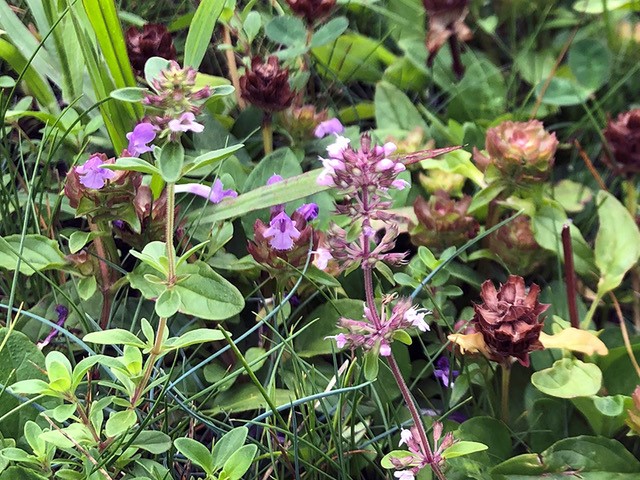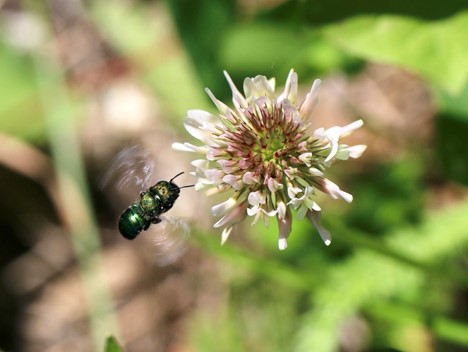What's a Flowering Bee Lawn?
2022-02-07 11:43:37
What is a flowering bee lawn?
Marirose Kuhlman, MPG Ranch

Lawns are a ubiquitous part of American urban and suburban life. Here in western Montana, lawns are a comfortable place to gather outdoors with family and friends for a barbeque or a game of soccer or football. In towns and cities, which are usually hotter than the surrounding landscape (known as the “urban heat island effect”), grassy lawns offer a cooler respite from the heat of the surrounding roads and parking lots. Lawns absorb excess water, helping to recharge aquifers and prevent soil erosion. Lawns can even help reduce the noise pollution of traffic.
For all their benefits to human-built environments, maintained lawns are ‘ecological wastelands’ that can consume a LOT of resources. Irrigating lawns can put a real strain on water resources, especially in naturally arid regions like ours, and during periods of drought when water supplies are already scarce. Fertilizers and pesticides, especially herbicides, are applied to lawns to keep them lush, green, and weed-free. Maintaining lawns takes time – homeowners may spend several hours each week mowing or maintaining their lawns and lawn equipment, or they spend money hiring professionals to do it for them. Also, lawns are typically composed of a single, Eurasian grass species, such as ‘Kentucky’ bluegrass. Most lawns are resource-intensive monocultures that offer very little food for pollinators or other beneficial insects and wildlife.
What can be done if you prefer the aesthetic of a verdant lawn, but want to take a more relaxed approach to lawn care while also helping pollinators and using fewer resources? Consider planting a Flowering Bee Lawn! Flowering bee lawns combine typical turfgrasses with other hardy grass species such as red fescue or sheep fescue, and low, flowering plants that benefit pollinators, like white clover, creeping thyme, self-heal, or yarrow. The increased diversity of bee lawns makes them more resilient to pests and environmental stressors than traditional Kentucky bluegrass lawns while requiring less frequent watering and mowing.
It does take some effort to plant a flowering bee lawn. But once it’s established, it may require less work and maintenance than a traditional lawn. An established bee lawn may need little to no supplemental watering, except during extended periods of hot, dry weather. Bee lawns can be mowed less frequently than a bluegrass-only lawn – perhaps every 2 or 3 weeks or more, depending on your site. Your bee lawn should be mowed to a height of around 3 inches to allow the flowers to bloom while still keeping a tidy appearance. Recycling the lawn clippings back into the lawn, rather than bagging and removing them, adds nutrients back into the soil and reduces the need for supplemental fertilizers. Any undesirable weed species can be hand-pulled while you’re establishing the bee lawn, and for the long term as well. And it's important not to spray pesticides on bee lawns – bee lawns are meant to provide a safe place for pollinators and many pesticides can sicken or kill pollinators.
Practical considerations for a Flowering Bee Lawn
Planting a bee lawn is not an all-or-nothing situation! Consider how you currently use your lawn and incorporate a bee lawn where it makes the most sense. Flowering bee lawns do best in places that receive light to moderate use. Perhaps there are areas of your yard where you don't spend as much time, like a boulevard strip, a front yard, or a side yard, that would be appropriate for a bee lawn. Remember that since you're planting flowers for bees and butterflies, it's a good idea to give them the space to forage in peace. Native bees are usually quite docile and not likely to sting, but areas where very young children play or where you like to walk barefoot are not ideal placements for bee lawn. Bee lawns can be planted wherever grass grows, so if you have problematic areas of your yard without grass it's also not likely to grow a successful bee lawn.
Helping pollinators and enjoying them, too!
Over 230 bee species have been documented in Missoula County, and over 360 bee species are recorded in the State of Montana! However, many bee species and butterfly species are known to be in decline from factors such as habitat loss or alteration, pesticide use, and diseases and parasites. A flowering bee lawn can attract many different species of bees, butterflies, and other pollinators to your yard, making it a safe place for these important insects. Pollinators thrive best when they have access to food resources in the form of flowering native plants, like shrubs, trees, annuals, and perennials, and a safe place to nest and overwinter. And while flowering bee lawns are not optimal pollinator habitats, they can provide food resources for butterflies, bees, and other pollinators, while doing double-duty as a comfortable and beautiful, low-maintenance lawn for you and your family. Ask your county extension agent or weed district manager if a flowering bee lawn is right for you!
For information and research on flowering bee lawns, visit the University of Minnesota Extension website: https://extension.umn.edu/landscape-design/planting-and-maintaining-bee-lawn#watering-2942960
